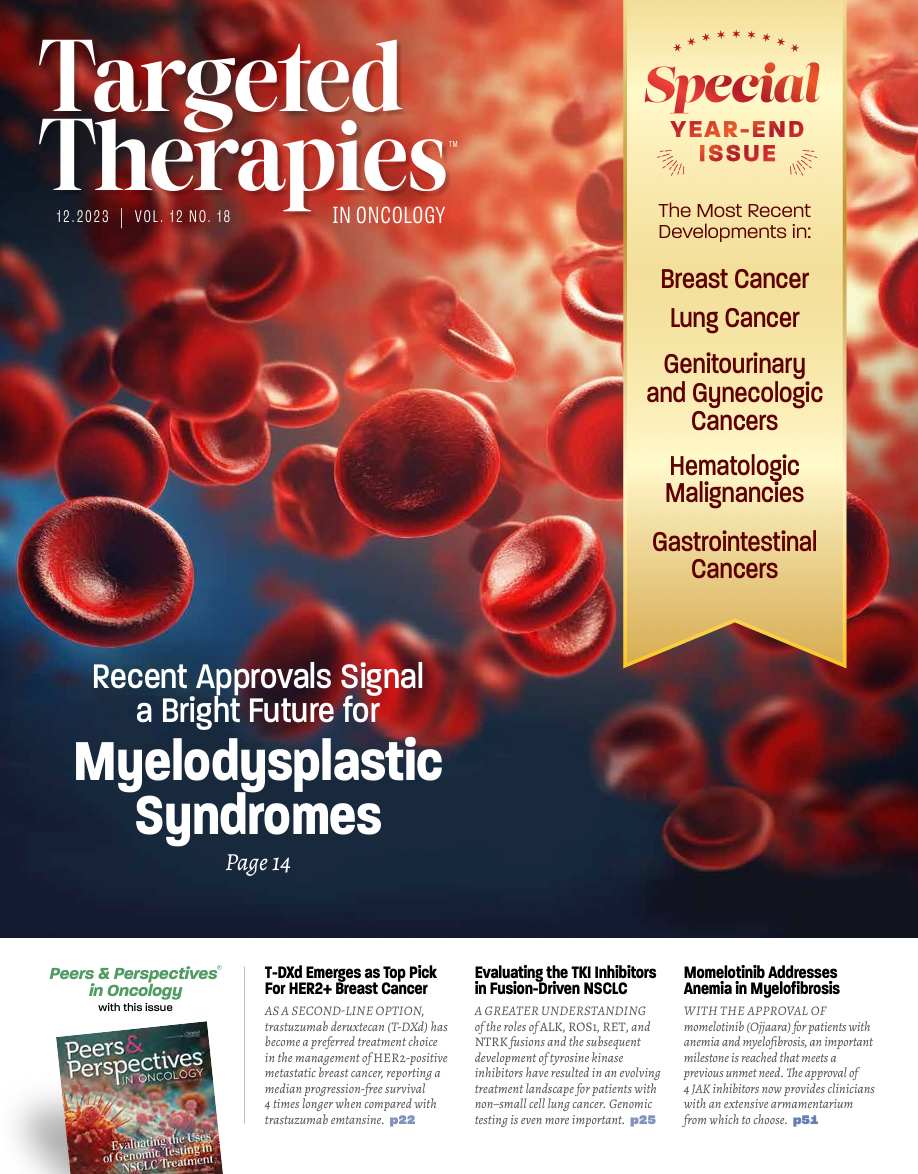ADC Choices Require Discretion in HER2-Negative MBC
As clinicians navigate the array of available antibody-drug conjugates for HER2-negative metastatic breast cancer, Joshua Z. Drago, MD, MS, emphasizes the importance of considering various factors in therapy selection and sequencing.

With numerous antibody drug conjugate (ADC) options now available for patients with HER2-negative metastatic breast cancer, clinicians must consider a variety of factors when selecting and sequencing therapies, according to Joshua Z. Drago, MD, MS, during the 41st Annual Chemotherapy Foundation Symposium Innovative Cancer Therapy for Tomorrow conference.1
“ADCs are being developed very rapidly for cancer therapy; the first ADC was approved back in 2000,” Drago, a breast oncologist at Memorial Sloan Kettering Cancer Center in New York, New York, said during the presentation. “With every 5-year period that progresses, we have a higher number of ADCs entering our clinical armamentarium; there are now over a dozen ADCs approved by the FDA, and over half of those were approved since 2020. There are over 300 of these [in preclinical development]. It’s very good news in terms of having lots of therapeutic options for our patients. But at the same time, this is going to introduce some complex questions about how we deploy these drugs clinically, how we sequence them, and how to pick which patients will benefit.”
Drago began his presentation by highlighting the 2 ADCs currently approved by the FDA for the treatment of patients with HER2-negative breast cancer: the HER2-directed fam-trastuzumab deruxtecan-nxki (T-DXd; Enhertu) and TROP2-directed sacituzumab govitecan-hziy (Trodelvy).
T-DXd was approved by the FDA in August 2022 for the treatment of adult patients with unresectable or metastatic HER2-low breast cancer who have received prior chemotherapy in the metastatic setting or developed recurrence during or within 6 months of completing adjuvant chemotherapy.2
In February 2023, the FDA approved sacituzumab govitecan for the treatment of patients with unresectable locally advanced or metastatic hormone receptor–positive, HER2-negative breast cancer who have received endocrine-based therapy and at least 2 additional systemic therapies in the metastatic setting.3
ASCENT Study
The first trial Drago discussed in detail was the phase 3 ASCENT study (NCT02574455), which he noted was the first trial with findings that eventually resulted in an approval of an ADC in HER2-negative MBC. ASCENT compared the safety and efficacy of sacituzumab govitecan vs those of physician’s choice of single-agent chemotherapy in patients with relapsed or refractory metastatic triple-negative breast cancer following at least 2 prior lines of chemotherapy.
The primary end point was progression- free survival (PFS) by blinded independent central review (BICR) in patients without brain metastases.4
Findings from the trial showed that at a median follow-up of 17.7 months (range, 5.8-28.1), the median PFS among patients without brain metastases was 5.6 months (95% CI, 4.3-6.3) vs 1.7 months (95% CI, 1.5-2.6) in the investigational (n = 235) and chemotherapy (n = 233) arms, respectively (HR, 0.41; 95% CI, 0.32-0.52; P < .001).
Additionally, the ADC resulted in significant overall survival (OS) compared with chemotherapy; the median values were 12.1 months (95% CI, 10.7-14.0) vs 6.7 months (95% CI, 5.8-7.7), respectively (HR, 0.48; 95% CI, 0.38-0.59; P < .001).4
“One thing I notice here is when you look at the survival curves, specifically in the control arm, over half of [patients] have progression on the first scan. That really underlines how high that baseline risk profile is for patients with metastatic triple-negative breast cancer that’s refractory to treatment and underlines the unmet need here,” Drago noted.
In terms of safety, Drago highlighted that treatment with sacituzumab govitecan led to relatively high rates of any-grade neutropenia (63%), diarrhea (59%), and nausea (57%). Growth factor support is often needed to allow for therapeutic doses of the ADC to be given, he said.4
TROPiCS-02 Trial
He then transitioned to the phase 3 TROPiCS-02 trial (NCT03901339), which also evaluated sacituzumab govitecan vs physician’s choice of chemotherapy but in patients with hormone receptor–positive, HER2-negative unresectable locally advanced or metastatic breast cancer following 2 to 4 lines of prior chemotherapy. The end point was PFS per RECIST 1.1 by BICR, with OS representing a key secondary end point.5
Findings from TROPiCS-02 trial showed that the median PFS in the investigational (n = 272) and control (n = 271) arms was 5.5 months (95% CI, 4.2-7.0) vs 4 months (95% CI, 3.1-4.4), respectively (HR, 0.66; 95% CI, 0.53-0.83; log-rank P = .0003).
The 6-month PFS rates were 46% vs 30%, respectively, and the 12-month PFS rates were 21% vs 7%. Sacituzumab govitecan also reduced the risk of death by 21% vs chemotherapy (HR, 0.79; 95% CI, 0.650.96; P = .02).5,6
Data from TROPiCS-02 supported the February 2023 FDA approval of sacituzumab govitecan.3
DESTINY-Breast04 Study
Drago transitioned to covering data from the phase 3 DESTINY-Breast04 study (NCT03734029), which supported the FDA approval of T-DXd in August 2022.
DESTINY-Breast04 enrolled patients with HER2-low MBC who underwent 1 to 2 prior lines of chemotherapy (n = 557), 88% of whom had hormone receptor– positive/HER2-negative disease. Patients were randomly assigned 2:1 to receive the ADC (n = 373) or single-agent chemotherapy (n = 184).7
In the overall population, the median PFS was 9.9 months (95% CI, 9.0-11.3) vs 5.1 months (95% CI, 4.2-6.8) in the investigational and control arms, respectively (HR, 0.50; 95% CI, 0.40-0.63; P < .001).
T-DXd provided a similar PFS benefit over chemotherapy in patients with hormone receptor–positive disease (HR, 0.51; 95% CI, 0.40-0.64; P < .001). In terms of OS, patients in the overall population and the hormone receptor–positive group both experienced 36% reduction in the risk of death with the ADC vs chemotherapy.7
“With regard to toxicity, neutropenia occurs but less commonly than with sacituzumab govitecan and nausea can certainly occur as well,” Drago said. “The most feared toxicity with T-DXd is pneumonitis, which happened in around 12% of patients in this trial, with some high-grade events and even those that were not survivable.”
Datopotamab Deruxtecan
Drago finished his presentation by touching on a therapy that has yet to receive FDA approval for patients with HER2- negative breast cancer, datopotamab deruxtecan (Dato-DXd).
The agent was evaluated in patients with hormone receptor–positive/HER2-negative MBC in the randomized phase 3 TROPION- Breast01 trial (NCT05104866).
The study randomly assigned patients 1:1 to receive the ADC (n = 365) or investigator’s choice of chemotherapy (n = 367). The coprimary end points were PFS by BICR and OS.8
Findings showed that the median PFS in the investigational arm was 6.9 months (95% CI, 5.7- 7.4) vs 4.9 months (95% CI, 4.2-5.5) in the control arm (HR, 0.63; 95% CI, 0.52-0.76; P < .0001). The 6-month PFS rates were 53.3% vs 38.5%, respectively, and the 12-month rates were 25.5% vs 14.6%, respectively.8
Drago noted that the toxicity of Dato-DXd differs from the available ADCs in some important ways. For example, the instance of any-grade neutropenia in the investigational arm was just 11% but any-grade stomatitis was more common, occurring at a rate of 50%.8
“Drago noted that the toxicity of Dato-DXd differs from the available ADCs in some important ways. For example, the instance of any-grade neutropenia in the investigational arm was just 11% but any-grade stomatitis was more common, occurring at a rate of 50%.
REFERENCES:
1. Drago JZ. ADCs in HER2-negative metastatic breast cancer. Presented at: Chemotherapy Foundation Symposium Innovation Cancer Therapy for Tomorrow; November 8-10, 2023; New York, NY.
2. FDA approves fam-trastuzumab deruxtecan-nxki for HER2-low breast cancer. News release. FDA. August 5, 2022. Accessed November 29, 2023. https://www.fda. gov/drugs/resources-information-approved-drugs/ fda-approves-fam-trastuzumab-deruxtecan-nxki-her2-low-breast-cancer
3. FDA approves sacituzumab govitecan-hziy for HR-positive breast cancer. FDA. February 3, 2023. Accessed November 29, 2023. https://www.fda.gov/drugs/resources-information-approved-drugs/fda-approves-sacituzumab-govitecan-hziy-hr-positive-breast-cancer
4. Bardia A, Hurvitz SA, Tolaney SM, et al; ASCENT Clinical Trial Investigators. Sacituzumab govitecan in metastatic triple-negative breast cancer. N Engl J Med. 2021;384(16):15291541. doi:10.1056/NEJMoa2028485
5. Rugo HS, Bardia A, Marmé F, et al. Overall survival with sacituzumab govitecan in hormone receptor-positive and human epidermal growth factor receptor 2-negative metastatic breast cancer (TROPiCS-02): a randomised, open-label, multicentre, phase 3 trial. Lancet. 2023;402(10411):14231433. doi:10.1016/S0140-6736(23)01245-X
6. Rugo HS, Bardia A, Marmé F, et al. Primary results from TROPiCS-02: a randomized phase 3 study of sacituzumab govitecan (SG) versus treatment of physician’s choice (TPC) in patients (pts) with hormone receptor-positive/HER2-negative (HR+/HER2-) advanced breast cancer. J Clin Oncol. 2022;40(suppl 17):LBA1001. doi:10.1200/JCO.2022.40.17_suppl.LBA1001
7. Modi S, Jacot W, Yamashita T, et al; DESTINY-Breast04 Trial Investigators. Trastuzumab deruxtecan in previously treated HER2-low advanced breast cancer. N Engl J Med. 2022;387(1):9-20. doi:10.1056/NEJMoa2203690
8. Bardi A, Jhaveri K, Im SA, et al. Datopotamab deruxtecan (Dato-DXd) vs chemotherapy in previously-treated inoperable or metastatic hormone receptor-positive, HER2-negative (HR+/HER2–) breast cancer (BC): primary results from the randomised phase III TROPION-Breast01 trial. Ann Oncol. 2023;34(suppl 2):S1264-S1265. doi:10.1016/j. annonc.2023.10.015
